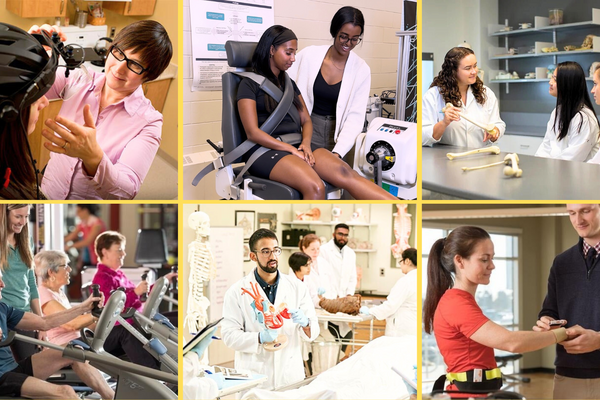
Changing attitudes on accessibility and inclusion
Paralympic athlete and Canadian icon Rick Hansen offers inspiring lecture

Paralympic athlete and Canadian icon Rick Hansen offers inspiring lecture
By Jenna Braun Faculty of HealthApproximately one in four Canadians — nearly 27 per cent — are living with some form of disability.
After a car accident 40 years ago left him with a spinal cord injury resulting in paralysis from the waist down, Rick Hansen says he often looks back at it all and wonders how he got so lucky.
“I would get back in that truck without blinking an eye and I would do it again and again,” Hansen says. “Because of the struggle. Because of the humanity I’ve experienced. And the purpose I’ve been able to apply.”
 Hansen was in Waterloo this week to share his story and mission, delivering the University of Waterloo’s Hallman Lecture titled: In motion towards building an inclusive and healthy world without barriers. Later in the week, he was granted an honorary doctorate from the Faculty of Health and addressed the graduating class.
Hansen was in Waterloo this week to share his story and mission, delivering the University of Waterloo’s Hallman Lecture titled: In motion towards building an inclusive and healthy world without barriers. Later in the week, he was granted an honorary doctorate from the Faculty of Health and addressed the graduating class.
Many know Rick Hansen as the “Man in Motion” for undertaking an epic 40,000 kilometre journey around the world in his wheelchair. From 1985 to 1987, Rick and his team wheeled through 34 countries raising awareness about the potential of people with disabilities and creating accessible and inclusive communities. He’s a three-time world champion, nine-time Pan Am gold medalist, six-time Paralympic medalist, and the founder of the Rick Hansen Foundation — an organization dedicated to removing barriers so that people with disabilities can live to their full potential.
But he didn’t always feel so fortunate.
When he was first told by doctors that he would never walk again, he says it hit him “like a brick.”
“In my earliest memories, my whole life revolved around physical activity, sport, the outdoors and the use of my legs,” he says.
Bedridden and on the brink of giving up, Hansen was asked by the nurses if he wanted or needed anything. He decided to ask for something he could do with his hands.
He was given rubber bands to work out his arms and began to develop strength-based goals. After hitting the milestone of being able to sit up in bed, and eventually being able to use a wheelchair, his outlook started to change.
On his recovery journey, he became acquainted with sports again, and was recruited to join the Vancouver Cable Cars basketball team by Stan Stronge, a paralympic athlete and peer counsellor for the paraplegic association.
“Every single time I saw this guy, there was this glow, this sense of optimism, this confidence that he was the captain of his destiny,” he recalls. “It’s not what happens to you, it’s what you do with it that counts.”
Shortly thereafter, Hansen enrolled at the University of British Columbia, where he later became the first person with a physical disability to graduate with a degree in physical education.
While playing for the Vancouver Cable Cars, Hansen recruited Terry Fox, who became a good friend of his.
“What I remember about Terry more than anything is that he made you realize that some of the biggest dreams in the world are killed by fear of failure,” Hansen says. “If you take the first step, you never know how far you will go.”
Hansen’s journey of positivity was persistent, though he continued to experience barriers and difficulties, within himself and in the places he went. Traveling the world, he saw injustice in many countries where people with disabilities did not have human rights.
“They were struggling with their disabilities but struggling even more with the society that was supposed to be welcoming them,” Hansen says. “The social, attitudinal and physical barriers didn’t have to be there.”
After struggling with his own attitude towards his disability, Hansen moved from a place of self-pity towards a focus on potential and ability.
“I knew if I could combine my athletic talents and take up wheeling around the world, then maybe it would help change attitudes and start a movement.”
But he was still learning to allow himself to lean on others.
During the Man In Motion World Tour, he recalls making it all the way to the Great Wall of China, seeing all the stairs, and telling his physiotherapist Amanda Reid (who would later become his wife), “I can’t go up there.”
It was the first place he encountered on the tour where he could not wheel himself to the destination.
Reid offered words of encouragement and said, “We've carried you every step of the way as your team — let us get you up the stairs.”
Hansen’s tour team included Reid, in addition to his coach, Tom Frick, his cousin, Robin-Lee Gibson and his friend Don Alder who was with him on the day of the accident. He describes them as the unsung Canadian heroes who worked to make his dreams a reality every day, under difficult conditions.
The tour raised $26 million, and changed the way people with disabilities are perceived on a global level. The Rick Hansen Foundation is part of the tour’s legacy and continues to raise awareness, change attitudes and remove barriers to inclusion.
“There are no walls too big in life that can't be climbed,” Hansen says. “You can either go over it, under it, around it or through it. We can find the way.”
The University of Waterloo is engaged in the Rick Hansen Foundation Accessibility Certification™ process, ongoing from 2021-2026 and spearheaded by the Faculty of Health to help improve the built environment for people with disabilities. A total of nine sites were rated with seven achieving certification, providing constructive information that will help to guide future upgrades and plans. The University is committed to improving accessibility and making an inclusive environment for people of all abilities.

Read more
From optometry and pharmacy to public health and therapeutics, Waterloo alumni are powering Canada’s health care sector

Read more
“I’m just like you.”

Read more
Dr. Troy Glover shares key strategies for improving health and well-being this year through collective community participation
The University of Waterloo acknowledges that much of our work takes place on the traditional territory of the Neutral, Anishinaabeg, and Haudenosaunee peoples. Our main campus is situated on the Haldimand Tract, the land granted to the Six Nations that includes six miles on each side of the Grand River. Our active work toward reconciliation takes place across our campuses through research, learning, teaching, and community building, and is co-ordinated within the Office of Indigenous Relations.